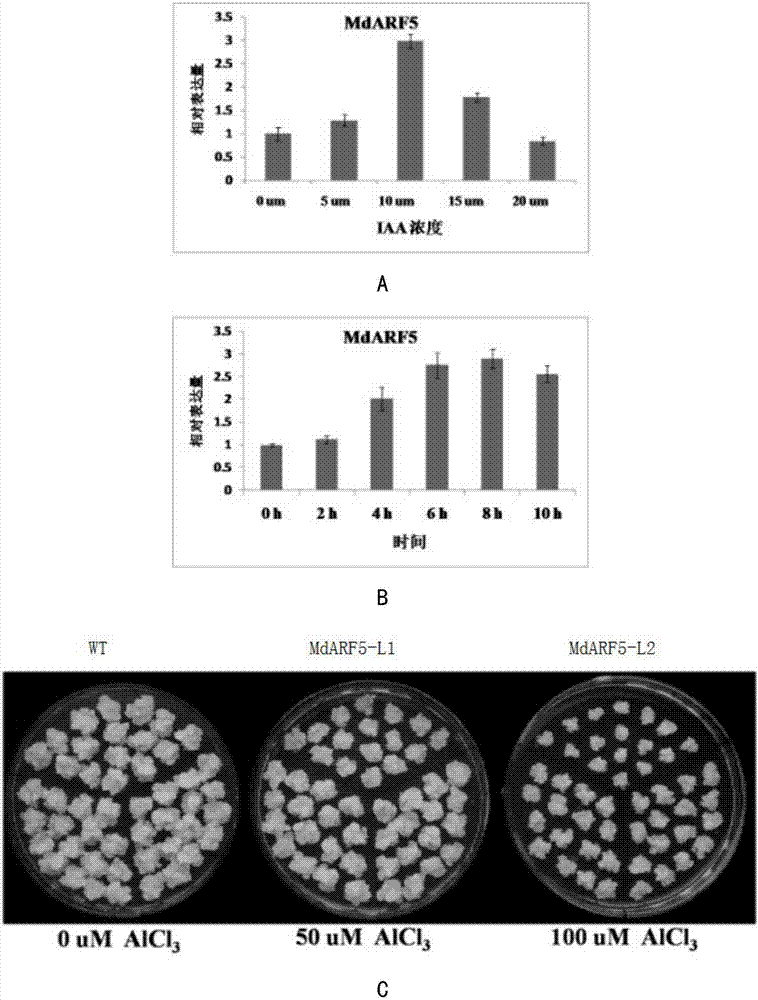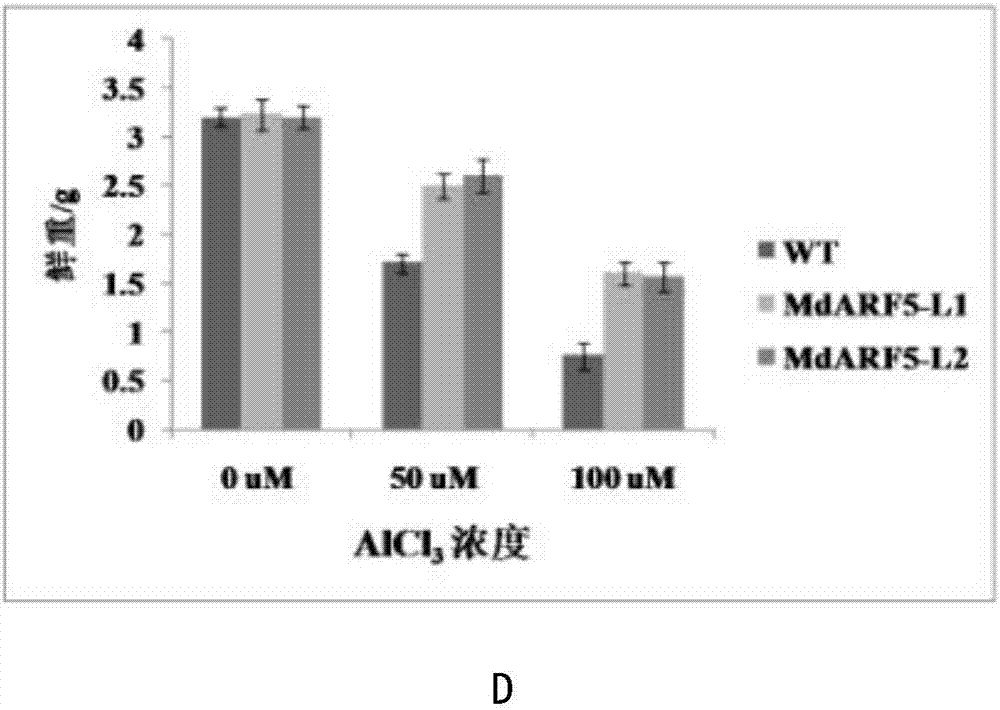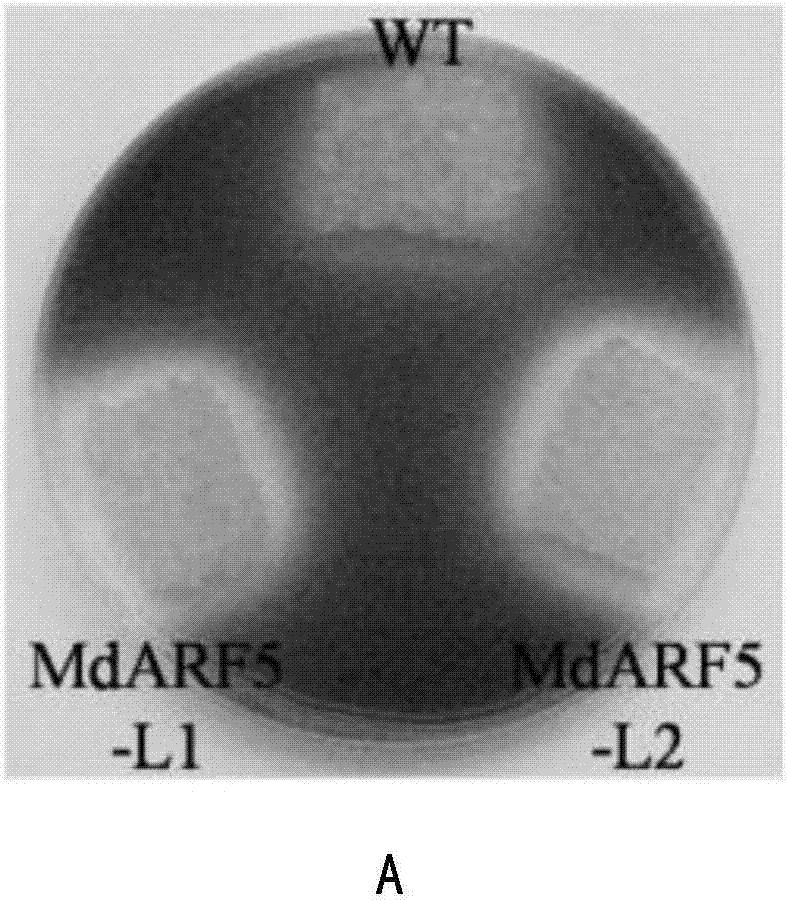Apple MdARF5 gene beneficial for apple callusing, and applications thereof
An apple and gene technology, applied in the field of molecular biology, can solve problems such as unclear mechanism, improve salt resistance and drought resistance, mature technical process, and improve the effect of plant salt resistance
- Summary
- Abstract
- Description
- Claims
- Application Information
AI Technical Summary
Problems solved by technology
Method used
Image
Examples
Embodiment 1
[0027] Embodiment 1: the cloning of apple MdARF5 gene
[0028] 1. Gala tissue culture leaf RNA extraction and reverse transcription
[0029] 1. Extract total RNA by CTAB method:
[0030] (1) Take 1.5 g of Gala apple tissue culture seedlings treated with 200 mM NaCl salt for 24 hours, put them into a pre-cooled mortar, add liquid nitrogen to grind, and transfer to a pre-cooled 50 mL centrifuge tube;
[0031] (2) Quickly add 10 mL of extraction buffer preheated to 65°C (in which PVP and mercaptoethanol are added immediately), mix gently, and place in a water bath at 65°C for 0.5 hour. The composition of the extraction buffer is shown in Table 1;
[0032] Table 1 Extraction buffer
[0033] CTAB
20% (w / v)
Tris-HCl
0.1mmol / L
EDTA
25mmol / L
NaCl
2mmol / L
Mercaptoethanol
2% (w / v)
pvp
2% (w / v)
RNase free ddH 2 o
Dilute to 100mL
[0034] (3) Add a water-saturated phenol / chloroform / isoamyl alcohol (25...
Embodiment 2
[0074] Embodiment 2: the acquisition of transgenic apple callus
[0075] 1) Pick a monoclonal colony of Agrobacterium and inoculate it in 10 mL of YEP liquid medium (containing 50 mg / L hygromycin), at 28° C., 200 rpm, and shake it until the OD600 is 06-0.8 (about 48 hours). Take 1 mL of the bacterial liquid and add it to 20 mL of YEP liquid medium, and culture it with shaking at 28°C and 200 rpm until the OD600 is 06-0.8 (about 5 hours). Bacteria were collected by centrifugation, ddH 2 O diluted to prepare the infection solution.
[0076] 2) Take wild-type apple callus in good growth state, place the callus in the infection solution and incubate for 30 minutes. After blotting dry with absorbent paper, pre-incubate for 1 day.
[0077] 3) Spread the apple callus pre-cultivated for 1 day on the selective medium (100 mg·L -1 Hyg) for 1-2 months.
[0078] 4) Screen the transgenic callus by gene detection.
Embodiment 3
[0079] Embodiment 3: Al ion stress resistance observation of transgenic apple callus
[0080] Use apple tissue culture seedlings that have grown for about 3 weeks and are growing well, and use different concentrations of Al 3+ Treatment, expression analysis experiments verified the expression response of MdARF5 to external aluminum ion stress, and the expression analysis results found that Al 3+ Significantly promote the expression of MdARF5 gene. At the same time, MdARF5 was genetically transformed into apple callus, and in Al 3+ The apple callus was processed under stress, and the growth curve was observed. The results showed that compared with the wild-type apple callus, the transgenic apple callus had a higher growth rate in Al 3+ faster growth rate under stress, such as figure 1 shown.
[0081] 3. Improvement of MdARF5 transgenic apple callus
[0082] The apple MdARF5 and wild-type calluses that were subcultured for about two weeks and grown well were grown on the su...
PUM
 Login to View More
Login to View More Abstract
Description
Claims
Application Information
 Login to View More
Login to View More - R&D
- Intellectual Property
- Life Sciences
- Materials
- Tech Scout
- Unparalleled Data Quality
- Higher Quality Content
- 60% Fewer Hallucinations
Browse by: Latest US Patents, China's latest patents, Technical Efficacy Thesaurus, Application Domain, Technology Topic, Popular Technical Reports.
© 2025 PatSnap. All rights reserved.Legal|Privacy policy|Modern Slavery Act Transparency Statement|Sitemap|About US| Contact US: help@patsnap.com



